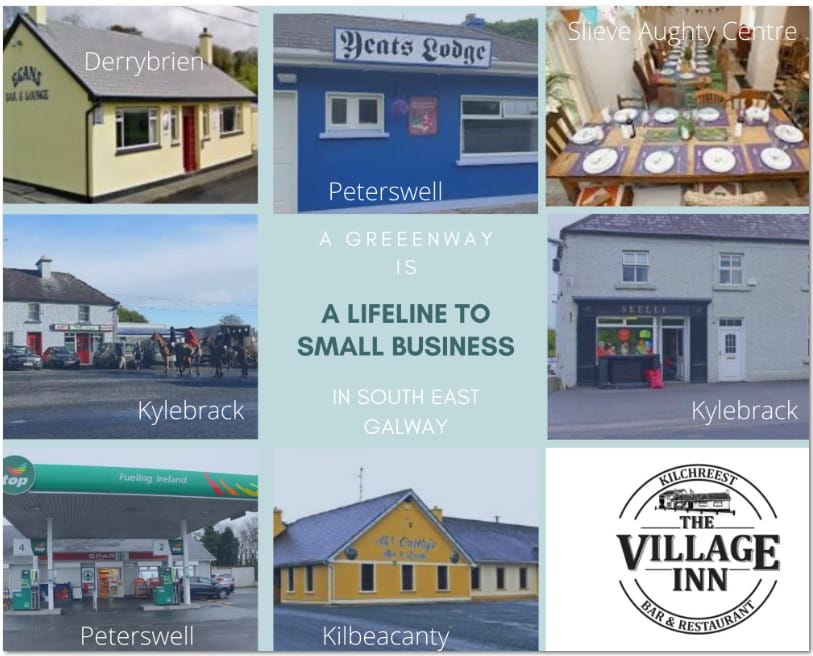Many of the rural communities on Route 5 have been declining for many years and are losing vital services. Kilchreest used to have post-office, shops, Garda station and a pub and today it has none of these. In 1991 the population of Eyrecourt was 358 and now it’s 252 and Woodford has fallen from 269 to 239.
Greenways can offer a lifeline to these communities and help kickstart a struggling rural economy and bring life back into the area.

In Project 2040 there is a strong focus on disadvantaged Rural Towns. It makes a distinction between rural areas located within the commuter catchment of the five city regions and large towns and those that are outside commuter catchments. It highlights that in less accessible rural areas, it has been challenging to retain and/or develop community and social facilities and local infrastructure as populations decline. Project 2040 – National Policy Objective 16 states “Target the reversal of rural decline in the core of small towns and villages through sustainable targeted measures that address vacant premises and deliver sustainable reuse and regeneration outcomes.”
As part of the Shared Goals – Our National Strategic Outcomes – It highlights that ‘Enhanced Amenities’ includes “amenities in rural areas, such as national and forest parks, activity-based tourism and trails such as greenways, blueways and peatways.“and under “5.4 Planning and Investment to Support Rural Job Creation”, it states that “The development of greenways, blueways and peatways offer a unique alternative means for tourists and visitors to access and enjoy rural Ireland“
The development of a strategic national network of these trails is a priority and will support the development of rural communities and job creation in the rural economy, as well as the protection. Such a network would allow for greater access to more remote parts of the country and presents opportunities for associated tourism development to take place in rural areas.
National Policy Objective 22 aims to “Facilitate tourism development and in particular a National Greenways, Blueways and Peatways Strategy, which prioritises projects on the basis of achieving maximum impact and connectivity at national and regional level.”
Where are the main disadvantages areas in County Galway
The CLÁR Program (Ceantair Laga Ard-Riachtanais) is a targeted investment programme for rural areas that aims to provide funding for small infrastructural projects in areas that experience disadvantage. The following are the CLÁR Areas identified in Ireland.

Independent of the scenic or segregation advantages, it is clear that the Red Route – Route 5 comes through the most disadvantaged rural communities and therefore offers the biggest opportunities and impacts for these communities
Route 5 offers biggest opportunities and impacts for disadvantaged communities
How can it transform ?
We have seen the potential of recreational tourism or ‘Activity Tourism’ thought the Waterford greenway which has injected a whole economic wave into both the immediate area and the county in general – and this isn’t from just oversees tourists but a staggering number of Irish residents also!
So what would ‘Activity Tourism Bring’? – It will bring a big increase in footfall into an area and people will want to partake in activities. People will want to participate in activities, some free, some provided – People will eat, drink and stay in scenic areas. People will need equipment or repair of equipment. People will want to socialize, need transport etc.
If we look at The Waterford Greenway – In December 2017, in a review of the previous 8 months it was estimated that 105,639 people walked the greenway and 141,906 cycled it. It had an average spend of about €30 Euro on Food and Drink and about €110 if they stayed overnight. That’s and incredible multi-million spend within a 46km route. It also seems to have an impact on the whole county as it has created a reason to visit the whole region. So this type of spend is what can bring a dramatic change to the sustainability of many of the local communities along the route. For instance on the Waterford route, about 1/3 of the cyclists surveyed hired a bike which would make tens of thousands of bike hires. That means several bike hire potentials and if we look at a map we see at least 10 bike hire places.

Similarly, a spate of new cafes sprung up overnight.

There’s a whole indirect service also. More people mean more wear-and-tear and more service – more electrics and plumbing, more bikes to repair, more trips to the pharmacy – more people to taxi around. There are even opportunities for baggage transfer. Greenways can revitalize an whole region very quickly creating plenty of summer jobs for the community and injecting some life into our rural regions!

3 thoughts on “Re-energising Rural Communities”